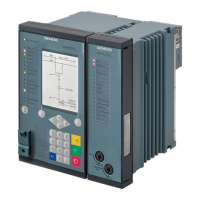The chatter-blocking settings have the following meaning (see also Figure 3-81 and Figure 3-82 in the exam-
ples shown in the following):
•
No. permis.state changes
This number specifies how often the state of a signal may toggle within the chatter-test time and the
chatter-checking time. If this number is exceeded, the signal will be or remains blocked.
Enter a number from 0 to 65535 in this field. If the entry is 0, chatter blocking is essentially inactive.
•
Initial test time
During this time, the number of times a signal changes its status is checked. This time is started if chatter
blocking is configured for at least one signal and this signal changes its status. If the configured number
of permissible status changes is exceeded during the initial test time, the signal is temporarily blocked
and the indication
Chatter blocking
is set.
Enter a number between 1 and 65535 in this field. The number entered corresponds to the time in
seconds. When the set time has expired, the timer restarts automatically (cycle time).
•
No. of chatter tests
This number specifies the maximum number of test cycles to be run. If the number of permissible status
changes of the signal stays exceeded during the initial test time of the last test cycle, the signal is finally
blocked. In this case, the indication
Group warning
(Alarm handling group and Device group) is set
additionally to the
Chatter blocking
indication after expiry of the set number. Restarting the devices
removes this block again.
Enter a number from 0 to 32767 in this field. The value Infinite (∞) is also permissible here.
Enter this value as character string oo.
•
Chatter idle time
If the number of permissible status changes for a signal is exceeded during the initial test time or the
subsequent test time, the Chatter idle time starts. Within this time, this signal is blocked tempora-
rily and the
Chatter blocking
indication is set. The blocked input signal is assigned the oscillatory
quality.
Enter a number between 1 and 65535 in this field. The number entered corresponds to the time in
minutes. An entry here is only considered if the number of chatter tests does not equal 0.
•
Subsequent test time
During this second test time, the number of times a signal changes its status is checked once again. The
time begins when the Chatter idle time expires. If the number of status changes is within the
permissible limits, the signal is released. Otherwise, an additional dead time begins, unless the maximum
number of chatter tests has been reached.
Enter a number between 2 and 65535 in this field. The number entered corresponds to the time in
seconds. An entry here is only considered if the number of chatter tests does not equal 0.
Example 1: Permanent Blocking
The chatter-blocking settings are set as follows:
•
No. permis.state changes = 4
•
No. of chatter tests = 2
After more than 4 state changes within the Initial test time, the input signal is set to the original state
by the chatter blocking and the oscillatory quality is assigned. Additionally, a corresponding indication is
added to the operational log. At the same time, the
Chatter blocking
indication is set. After expiry of the
settable Chatter idle time, during the following Subsequent test time, it is checked whether the
input signal is still chattering. This check is repeated, as the No. of chatter tests is set to 2 in this
example.
If, during the 2nd Subsequent test time, it has been detected that the number of status changes of the
input signal exceeds the set No. permis.state changes, the chatter blocking detects a persistent viola-
tion of the signal stability and sets the
Group warning
indication. The original state of the signal is perma-
nently frozen. Only a device restart removes the chatter blocking again.
System Functions
3.8 Other Functions
SIPROTEC 5, High-Voltage Bay Controller, Manual 145
C53000-G5040-C015-9, Edition 11.2017

